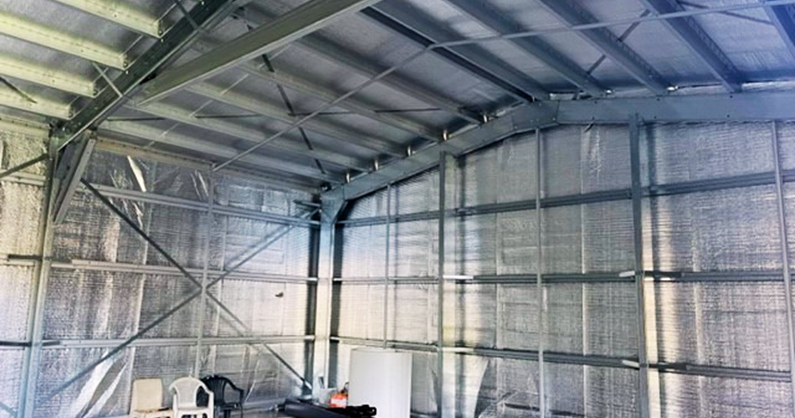Is It Worth It to Insulate a Storage Shed?

The benefits of insulating your shed outweigh the disadvantages and shed insulation can be a fantastic money-saving solution for many homeowners. Insulating your shed will lessen the likelihood of moisture entering it, making it an excellent addition to your property. It may also be used to store wet weather gear, outdoor sports equipment, camping equipment, and even prams and car seats. Those belongings will remain dry and secure, and the shed will free up valuable living space for you to employ for more important tasks. Continue reading to discover some of the most significant benefits and whether insulating your storage shed is worthwhile.
Lowers energy consumption
Shed insulation comes in many different types and can be used for various purposes. Wool, for example, can survive high heat, but it is necessary to clean it regularly to keep odors and dirt out. Fiberglass, blown-in insulation, and foam are some more types of insulation. The thickness and type of insulation used will be determined by the size and composition of the shed.
Insulating a shed, regardless of its purpose, will cut energy usage in various ways. For example, it will keep your belongings cooler during hotter weather and help you save money on heating and cooling. Insulating a shed might also help to safeguard your upholstered furniture. It also keeps moisture from collecting on wood and objects.
Lowers Condensation
Insulating a shed will improve its energy efficiency and reduce the quantity of condensation it creates. This is a great idea for sheds in Emerald or other locations that can have hot days and cold nights. Insulation raises the temperature of surfaces and prevents moisture build-up, which can damage wood, metal, and upholstered items. Closed-cell foam insulation is an excellent vapor barrier. Another aspect to consider while insulating a shed is holes and crevices that allow moisture to enter. These include roof joints and the shed's foundation. Check for moist patches and reseal them if necessary.
If your shed is made of steel, consider installing a damp-proof base to decrease the amount of moisture that can accumulate. Installing an insulating covering will also help to reduce moisture at the shed's base. While this strategy cannot avoid all condensation, it is a low-cost way to keep excess moisture from accumulating on interior surfaces.
Reduces the risk of fire
A well-insulated shed reduces the possibility of a fire. The amount of insulation required is determined by your climate. Check with your local building inspector to find out what the minimal values are in your area. A hot climate, for example, will require less insolation than a cold climate. In addition, some types of insulation, such as stone wool, are non-combustible.
Adding plywood to a shed's walls and roof can help to limit heat transfer from inside to outside. Insulating pipes is another excellent approach to prevent heat transfer. These pipes can be wrapped in polyethene roll and secured with rope, spray adhesive, or adhesive tape.
Saves money
Insulating a shed helps you save money on heating your outdoor storage area. Furthermore, insulating a shed can make the room more comfortable and keep the temperature steady. Insulation is essential for sheds because it reduces heat loss via the walls, roof, and floor.
Cutting the insulation boards to fit neatly between the structure is the first step in installing insulation in a shed. To act as a vapor barrier, foil is also added to the insulation. It keeps moisture from becoming trapped in the insulation and causing dampness between the walls. To guarantee air tightness, the insulation is then taped around the edges with aluminum tape. After that, the inside walls can be boarded up.
The insulation's R-value should be between R-13 and R-23. R-13 through R-30 are enough for the floor. The R-value varies according to where you live and the climate. A hot climate does not necessitate the same level of insulation as a cold climate.
Simple to Set Up
Insulating a shed requires only a few easy actions. First, it is recommended to remove the contents of the shed and inspect the entire construction. This allows you to identify any flaws or gaps that need to be addressed. The roof of a shed is the primary source of heat loss, so be sure it's in good condition. If the roll roofing is damaged, it must be replaced, although smaller holes can be patched.
To begin, measure the shed's roof and walls. After you've gathered this information, trim the foam board to size. The foam board should then be covered with a fireproof vapor barrier. Remember to protect yourself from fire hazards by using gloves and goggles.

Conclusion
Before you decide to install insulation, examine the purpose of your storage shed and how it will fit into your shed designs. With so many different types of sheds to choose from, this shed plans collection covers a diverse choice of shed designs and alternatives. This will determine whether the expense is worthwhile. Remember that selecting the proper sort of insulation for your storage shed is a big decision. Varied materials have different insulating capacities, and you should consider the size and composition of your shed before selecting an insulating material.

